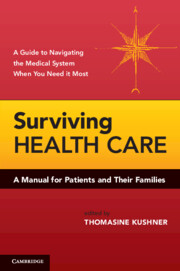Book contents
- Frontmatter
- Contents
- Contributors
- Preface
- 1 Letter to Patients
- 2 Becoming an Active Member of Your Health Care Team
- 3 Information That Will Help You with Advance Planning for Your Health Care
- 4 Responding to Medical Emergencies
- 5 What You Need to Know about Medical Errors
- 6 Being Informed When You Give Consent to Medical Care
- 7 Beware of Scorecards
- 8 Transplantation 101
- 9 When the Illness Is Psychiatric
- 10 On the Horizon
- 11 To Be or Not to Be – A Research Subject
- 12 Information That Will Help You Make Health Care Decisions for Adult Family Members
- 13 Caring for Individuals with Alzheimer's Disease
- 14 When the Patient Is a Child
- 15 Care of Elders
- 16 Being and Thinking
- 17 A Patient's Guide to Pain Management
- 18 The Hardest Decisions
- 19 What You Need to Know about Disasters
- 20 Making the Internet Work for You
- Appendix: Patient Individual Profile
- Index
4 - Responding to Medical Emergencies
Published online by Cambridge University Press: 05 June 2012
- Frontmatter
- Contents
- Contributors
- Preface
- 1 Letter to Patients
- 2 Becoming an Active Member of Your Health Care Team
- 3 Information That Will Help You with Advance Planning for Your Health Care
- 4 Responding to Medical Emergencies
- 5 What You Need to Know about Medical Errors
- 6 Being Informed When You Give Consent to Medical Care
- 7 Beware of Scorecards
- 8 Transplantation 101
- 9 When the Illness Is Psychiatric
- 10 On the Horizon
- 11 To Be or Not to Be – A Research Subject
- 12 Information That Will Help You Make Health Care Decisions for Adult Family Members
- 13 Caring for Individuals with Alzheimer's Disease
- 14 When the Patient Is a Child
- 15 Care of Elders
- 16 Being and Thinking
- 17 A Patient's Guide to Pain Management
- 18 The Hardest Decisions
- 19 What You Need to Know about Disasters
- 20 Making the Internet Work for You
- Appendix: Patient Individual Profile
- Index
Summary
You're suddenly faced with a medical emergency for yourself or a loved one. What do you do? The real key is to be prepared. Knowing when to “push the alarm button,” what to expect, and then how to get the best possible treatment may be the most important elements of your response to an emergency – and preparation is something you can do now.
Preparing for an Emergency
Health care workers are not omniscient. They need accurate information about your medical conditions to give you the best (and fastest) possible treatment. In an emergency, however, you may not recall all the information they need to make good decisions.
Wallet card. Always carry a card in your wallet or purse with the basic information that ambulance and hospital caregivers will need, including:
Your name and birth date, for identification purposes
The name(s) and contact information of your family (surrogate decision makers) and doctors (include their specialty)
List of any allergies to medication and to anything else
A brief medical history, including the dates, places (hospitals), and types of any operations; the dates and types of any serious medical illnesses; and the dates and reasons for any other hospitalizations. If you don't know the specific diagnosis, contact your doctor for the information.
A list of any significant laboratory or x-ray findings. List the values for the tests (e.g., hemoglobin: 18 gm/dL; creatinine: 1.1 mg/dL). One small problem is that the United States, Canada, and some other countries use a gram/deciliter (gm/dL) system, whereas Europe and other countries report values as mole/liter (mol/L). Nevertheless, if you have your current laboratory values in either system, physicians will find this information useful. Copy this information directly from the laboratory results form you receive or get it from your doctor's office.
[…]
- Type
- Chapter
- Information
- Surviving Health CareA Manual for Patients and Their Families, pp. 46 - 55Publisher: Cambridge University PressPrint publication year: 2010



